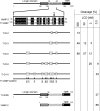Substrate recognition mechanism of VAMP/synaptobrevin-cleaving clostridial neurotoxins
- PMID: 18511418
- PMCID: PMC3258937
- DOI: 10.1074/jbc.M800610200
Substrate recognition mechanism of VAMP/synaptobrevin-cleaving clostridial neurotoxins
Abstract
Botulinum neurotoxins (BoNTs) and tetanus neurotoxin (TeNT) inhibit neurotransmitter release by proteolyzing a single peptide bond in one of the three soluble N-ethylmaleimide-sensitive factor attachment protein receptors SNAP-25, syntaxin, and vesicle-associated membrane protein (VAMP)/synaptobrevin. TeNT and BoNT/B, D, F, and G of the seven known BoNTs cleave the synaptic vesicle protein VAMP/synaptobrevin. Except for BoNT/B and TeNT, they cleave unique peptide bonds, and prior work suggested that different substrate segments are required for the interaction of each toxin. Although the mode of SNAP-25 cleavage by BoNT/A and E has recently been studied in detail, the mechanism of VAMP/synaptobrevin proteolysis is fragmentary. Here, we report the determination of all substrate residues that are involved in the interaction with BoNT/B, D, and F and TeNT by means of systematic mutagenesis of VAMP/synaptobrevin. For each of the toxins, three or more residues clustered at an N-terminal site remote from the respective scissile bond are identified that affect solely substrate binding. These exosites exhibit different sizes and distances to the scissile peptide bonds for each neurotoxin. Substrate segments C-terminal of the cleavage site (P4-P4') do not play a role in the catalytic process. Mutation of residues in the proximity of the scissile bond exclusively affects the turnover number; however, the importance of individual positions at the cleavage sites varied for each toxin. The data show that, similar to the SNAP-25 proteolyzing BoNT/A and E, VAMP/synaptobrevin-specific clostridial neurotoxins also initiate substrate interaction, employing an exosite located N-terminal of the scissile peptide bond.
Figures




References
-
- Schiavo, G., Matteoli, M., and Montecucco, C. (2000) Physiol. Rev. 80 717-766 - PubMed
-
- Sollner, T., Bennett, M. K., Whiteheart, S. W., Scheller, R. H., and Rothman, J. E. (1993) Cell 75 409-418 - PubMed
-
- Schiavo, G., Rossetto, O., and Montecucco, C. (1994) Semin. Cell Biol. 5 221-229 - PubMed
-
- Niemann, H., Blasi, J., and Jahn, R. (1994) Trends Cell Biol. 4 179-185 - PubMed
-
- Advani, R. J., Bae, H. R., Bock, J. B., Chao, D. S., Doung, Y. C., Prekeris, R., Yoo, J. S., and Scheller, R. H. (1998) J. Biol. Chem. 273 10317-10324 - PubMed
Publication types
MeSH terms
Substances
LinkOut - more resources
Full Text Sources
Other Literature Sources

